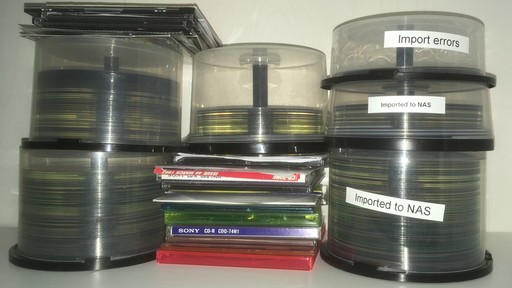jmtd → computing → imaging discs → Imaging DVD-Rs: Overview and Step 1
This is part 1 in a series about a project to read/import a large collection of home-made optical media. Part 2 is Imaging DVD-Rs: Initial import of the discs, the summary page for the whole project is imaging discs
From the late 1990s until relatively recently, I used to archive digital material onto CD-Rs, and later DVD-Rs. I've got about half a dozen spindles of hundreds of home-made discs with all sorts of stuff on them. A project to import them to a more future-proof storage location is long overdue. If you are in a similar position, consider a project like this as soon as possible: based on my experiences it might already be too late for some of them. The adjacent pictures were created with the ddrescueview software and show both a degraded home-made DVD-R and a degraded commercially pressed CD-ROM. I came across both as I embarked on this project.
The process can be divided into roughly five stages:
- Gather the discs & preparation
- Initial import of the discs
- Figuring out disc contents
- Retrying damaged/degraded discs
- Organising the extracted files
If you are importing a lot of discs, the stages can run like a pipeline, where you perform steps 3 onwards for some images whilst you are beginning stage 2 for others.
I'll be writing in more depth about each step separately. To start, here's the preparatory step.
Pre-requisites
Where are you storing what you import? Do you trust that place? If not, fix that first. For me, setting up a home NAS and robust backup was an essential pre-requisite for this project.
Preparation (gather the discs)
Fetch all the discs you want to read together into one place.
I had some in jewel cases and others on the spindles that the blank discs come on. I had some at my house, some in boxes at my parents house and more at work. I decided to consolidate most of the discs down onto the spindles and throw away most of the jewel cases. If you suspect a particular disc as having particularly valuable data on it, you may wish to leave it in a jewel case. You might also want to hang onto one or two empty jewel cases, if there's a chance you'll happen upon a disc you want to give to someone else.
 |
I dedicated an initially-empty spindle as the "done" spindle, opting to keep the imported discs, at least until the import process was complete. I also kept a second "needs attention" spindle for discs that couldn't be read successfully straight away. I labelled both using a label-maker.
Don't trust disc labels: If in doubt, put the disc in your "to image" pile. Don't throw a disc out on the basis of the label alone. I had a bad habit of topping up a disc which was mostly for one thing with other data if there was space left over. Mistakes can also be made, and I had plenty of unlabelled discs anyway.
You're going to need a computer with sufficient storage space upon which to store the disc images, metadata and/or the data within them, once you start organising it. You're also going to need an optical drive to read them. If you haven't yet got a system in place for reliably storing your data and managing backups, it would be worth sorting that out first before embarking on a project like this.
I attached a USB drive to my NAS and did the importing and storing directly onto it.
Finally, this is going to take time. In the best case, discs read quickly and reliably, and the time is spent simply inserting them and ejecting them. In the worst case, you might have troublesome discs that you really want to attempt to read everything from, which can take a great deal of (unattended) time.
On to Part 2: Initial import of the discs, or the article index.

